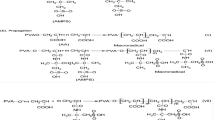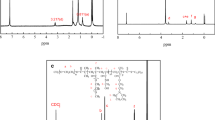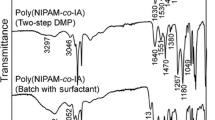Abstract
The objective of this research is to explore the synthesis of a new family of water soluble polycationic copolymeric precursors that could be photo-crosslinked into hydrogels. The in vitro control release of ovalbumin protein (OVA) from this family of hydrogels was also studied to assess the biomedical potential of this new family polycationic hydrogels. A series of novel poly(VCL–AETA) copolymer hydrogels was fabricated in an aqueous medium via photo-induced polymerization and crosslinking of hydrophobic N-vinylcaprolactam (VCL) and hydrophilic [2-(acryloxy)ethyl]trimethylammonium chloride (AETA) monomers over a wide range of VCL to AETA feed molar ratios of 2:1, 1:1, 1:2, 1:5. N,N′-methylene bisacrylamide (MBA) was used as a crosslinker. Ovalbumin (OVA), a model antigen, was preloaded into poly(VCL–AETA) hydrogel precursors and its release profiles in pH 7.4 PBS at 37°C were investigated as a function of VCL to AETA monomer feed ratios over a period of 4 weeks. The in vitro results showed that OVA initial burst and subsequent sustained releases could be controlled by 3 material parameters: the hydrophobic VCL to hydrophilic AETA monomer feed ratios, crosslinking density and hydrogel degradation rate. Thus, the hydrophobic-hydrophilic VCL–AETA hydrogel network for controlled OVA release could offer advantages over organic solvent-based single component polymer system. However, these in vitro OVA release profiles may change in an in vivo environment.







Similar content being viewed by others
References
T. Uchida, S. Goto, Biol. Pharm. Bull. 17, 1272 (1994)
M.-A. Benoit, B. Baras, J. Gillard, Int. J. Pharm. 184, 73 (1999). doi:10.1016/S0378-5173(99)00109-X
S.W. Cho, S.H. Song, Y.W. Choi, Arch. Pharm. Res. 23, 385 (2000)
T. Kissel, Y.X. Li, C. Volland, S. Gorich, R. Koneberg, J. Control. Release 39(2–3), 315 (1996). doi:10.1016/0168-3659(95)00163-8
K.F. Pistel, A. Breitenbach, R. Zange-Volland, T. Kissel, J. Control. Release 73(1), 7 (2001). doi:10.1016/S0168-3659(01)00231-0
N. Murthy, M.C. Xu, S. Schuck, J. Kunisawa, N. Shastri, J.M.J. Frechet, Proc. Natl. Acad. Sci. USA 100(9), 4995 (2003). doi:10.1073/pnas.0930644100
V. Grabstain, H. Bianco-Peled, Biotechnol. Prog. 19(6), 1728 (2003). doi:10.1021/bp034161t
R. Nakaoka, Y. Tabata, Y. Ikada, Biomaterials 17(23), 2253 (1996). doi:10.1016/0142-9612(96)00034-8
K. Podual, F.J. III Doyle, N.A. Peppas, Polymer (Guildf) 41(3), 975 (2000). 10.1016/S0032-3861(99)00236-0
N.A. Peppas, P. Bures, W. Leobandung, H. Ichikawa, Eur. J. Pharm. Biopharm. 50, 27 (2000). doi:10.1016/S0939-6411(00)00090-4
N.A. Peppas, B.S. Kim, C. Donini, O. Sipahigil, W, Leobandung, in Stimuli-Sensitive Polymers for Oral and Parenteral Administration, New Trends in Polymers for Oral and Parenteral Administration: From Design to Receptors, ed. G. Barratt, D. Duchene, F. Fattal, J.Y. Legendre (Editions de Sante, Paris, 2001), p. 32
N.A. Peppas, Y. Huang, Pharm. Res. 19(5), 578 (2002). doi:10.1023/A:1015389609344
S. Horiike, K. Yumoto, S. Matsuzawa, K. Yamaura, Polym. Adv. Technol. 14(6), 422 (2003). doi:10.1002/pat.350
P.K. Smith, R.I. Krohn, G.T. Hermanson, A.K. Mallia, F.H. Gartner, M.D. Provenza et al., Anal. Biochem. 150, 76 (1985). doi:10.1016/0003-2697(85)90442-7
V.I. Lozinsky, I.A. Simenel, E.A. Kurskaya, V.K. Kulakova, I.Y. Galaev, B. Mattiasson et al., Polymer (Guildf) 41, 6507 (2000). doi:10.1016/S0032-3861(99)00844-7
D.-Q. Wu, X.-Z. Zhang, C.C. Chu, J. Biomater. Sci. Polym. Ed. 14, 777 (2003). doi:10.1163/156856203768366521
S.H. Kim, C.Y. Won, C.C. Chu, J. Biomed. Mater. Res. 46(2), 160 (1999). 10.1002/(SICI)1097-4636(199908)46:2<160::AID-JBM4>3.0.CO;2-P
L. Pratt, C. Chu, J. Auer, A. Chu, J. Polym. Sci. Part Polym. Chem. 31, 1759 (1993). doi:10.1002/pola.1993.080310715
S.R. Van Tomme, B.G. De Geest, K. Braeckmans, S.C. De Smedt, F. Siepmann, J. Siepmann et al., J. Control. Release 110(1), 67 (2005). doi:10.1016/j.jconrel.2005.09.005
K.S. Soppimath, A.R. Kulkarni, T.M. Aminabhavi, J. Biomater. Sci. Polym. Ed. 11, 27 (2000). doi:10.1163/156856200743472
T.L. Lowe, H. Tenhu, H. Tylli, J. Appl. Polym. Sci. 73, 1031 (1999). doi:10.1002/(SICI)1097-4628(19990808)73:6≤1031::AID-APP22≥3.0.CO;2-C
A. Kishida, K. Murakami, H. Goto, M. Akashi, H. Kubita, T. Endo, J. Bioact. Compat. Polym. 13, 270 (1998)
D.-Q. Wu, X.-Z. Zhang, C.C. Chu, Am. J. Drug. Deliv. 3(4), 253 (2005). doi:10.2165/00137696-200503040-00005
Acknowledgement
Supported by a NIH grant R01-DE015143-01A2 to F.A. Chen of NYU.
Author information
Authors and Affiliations
Corresponding author
Rights and permissions
About this article
Cite this article
Wu, DQ., Chu, CC. & Chen, F.A. Cationic poly(VCL–AETA) hydrogels and ovalbumin (OVA) release in vitro. J Mater Sci: Mater Med 19, 3593–3601 (2008). https://doi.org/10.1007/s10856-008-3523-1
Received:
Accepted:
Published:
Issue Date:
DOI: https://doi.org/10.1007/s10856-008-3523-1




